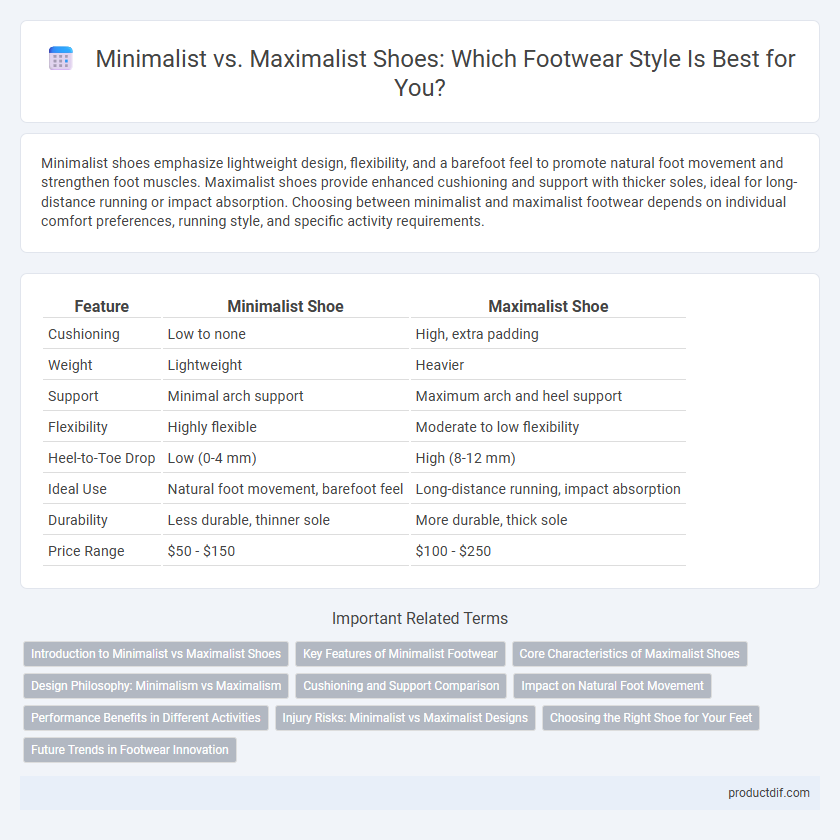Minimalist shoes emphasize lightweight design, flexibility, and a barefoot feel to promote natural foot movement and strengthen foot muscles. Maximalist shoes provide enhanced cushioning and support with thicker soles, ideal for long-distance running or impact absorption. Choosing between minimalist and maximalist footwear depends on individual comfort preferences, running style, and specific activity requirements.
Table of Comparison
| Feature | Minimalist Shoe | Maximalist Shoe |
|---|---|---|
| Cushioning | Low to none | High, extra padding |
| Weight | Lightweight | Heavier |
| Support | Minimal arch support | Maximum arch and heel support |
| Flexibility | Highly flexible | Moderate to low flexibility |
| Heel-to-Toe Drop | Low (0-4 mm) | High (8-12 mm) |
| Ideal Use | Natural foot movement, barefoot feel | Long-distance running, impact absorption |
| Durability | Less durable, thinner sole | More durable, thick sole |
| Price Range | $50 - $150 | $100 - $250 |
Introduction to Minimalist vs Maximalist Shoes
Minimalist shoes emphasize a lightweight design, flexible soles, and minimal cushioning, promoting natural foot movement and ground feel. Maximalist shoes feature thick, cushioned midsoles that provide enhanced shock absorption and support for long-distance running and comfort. Choosing between minimalist and maximalist footwear depends on individual biomechanics, running style, and injury prevention needs.
Key Features of Minimalist Footwear
Minimalist footwear features a lightweight design with a thin, flexible sole that promotes natural foot movement and ground feel, often measuring less than 10mm in sole thickness. It lacks significant cushioning or arch support to encourage foot muscle strengthening and proprioception. The design typically includes a zero-drop heel-to-toe ratio, allowing the foot to strike the ground in a natural position.
Core Characteristics of Maximalist Shoes
Maximalist shoes feature thick, cushioned midsoles that provide enhanced shock absorption and superior comfort for long-distance running or walking. These shoes often incorporate multiple layers of foam and advanced materials to maximize energy return and support. Their bulky design offers exceptional stability and protection, catering to athletes seeking extra cushioning and impact resistance.
Design Philosophy: Minimalism vs Maximalism
Minimalist shoes emphasize lightweight construction, thin soles, and minimal cushioning to promote natural foot movement and enhance sensory feedback. Maximalist shoes feature thick, heavily cushioned midsoles designed to absorb shock and provide maximum comfort during extended wear or high-impact activities. The design philosophy of minimalism prioritizes simplicity and functionality, whereas maximalism focuses on enhanced protection and support through added materials and bulk.
Cushioning and Support Comparison
Minimalist shoes offer minimal cushioning designed to promote natural foot movement and enhance ground feel, ideal for users seeking a barefoot-like experience. Maximalist shoes feature thick, plush cushioning that provides superior shock absorption and enhanced support, helping reduce impact on joints during prolonged or high-intensity activities. Choosing between minimalist and maximalist footwear depends on individual biomechanics, running style, and injury prevention needs.
Impact on Natural Foot Movement
Minimalist shoes promote natural foot movement by offering lightweight designs, minimal cushioning, and flexible soles that allow toes to splay and feet to flex naturally. Maximalist shoes feature thick cushioning and elevated midsoles, which can restrict foot mobility and alter gait patterns by absorbing shock but reducing proprioceptive feedback. Choosing minimalist footwear supports strengthening foot muscles and enhancing balance, while maximalist shoes prioritize impact protection at the potential cost of natural biomechanics.
Performance Benefits in Different Activities
Minimalist shoes enhance natural foot mechanics, promoting better ground feel and agility, making them ideal for activities requiring quick movements like trail running and gym workouts. Maximalist shoes provide superior cushioning and shock absorption, reducing impact stress during long-distance running and endurance sports. Selecting the right footwear depends on activity type, with minimalist shoes boosting responsiveness and maximalist shoes enhancing comfort and injury prevention.
Injury Risks: Minimalist vs Maximalist Designs
Minimalist shoes, characterized by thin soles and minimal cushioning, increase foot muscle activation but may raise the risk of stress fractures and plantar fasciitis due to reduced shock absorption. Maximalist shoes feature thick midsoles and enhanced cushioning, which can lower impact forces but might contribute to overuse injuries by altering natural gait mechanics. Choosing between minimalist and maximalist footwear depends on individual biomechanics and gradual adaptation to prevent injury.
Choosing the Right Shoe for Your Feet
Minimalist shoes offer lightweight design and enhanced ground feel, promoting natural foot movement and strengthening foot muscles, ideal for runners seeking a barefoot-like experience. Maximalist shoes provide extra cushioning and support with thick midsoles, reducing impact forces and minimizing injury risk for those who prefer comfort and shock absorption. Selecting the right shoe depends on your running style, foot biomechanics, and terrain, ensuring optimal protection and performance tailored to your feet's needs.
Future Trends in Footwear Innovation
Future trends in footwear innovation emphasize the integration of advanced materials and biomechanics to enhance performance and comfort in both minimalist and maximalist shoe designs. Minimalist shoes are evolving with ultra-lightweight, breathable fabrics that promote natural foot movement, while maximalist shoes incorporate responsive cushioning technologies to improve shock absorption and energy return. The convergence of sustainability and smart technologies is driving the development of adaptive footwear that personalizes support and adapts to various activities in real time.
Minimalist Shoe vs Maximalist Shoe Infographic

 productdif.com
productdif.com